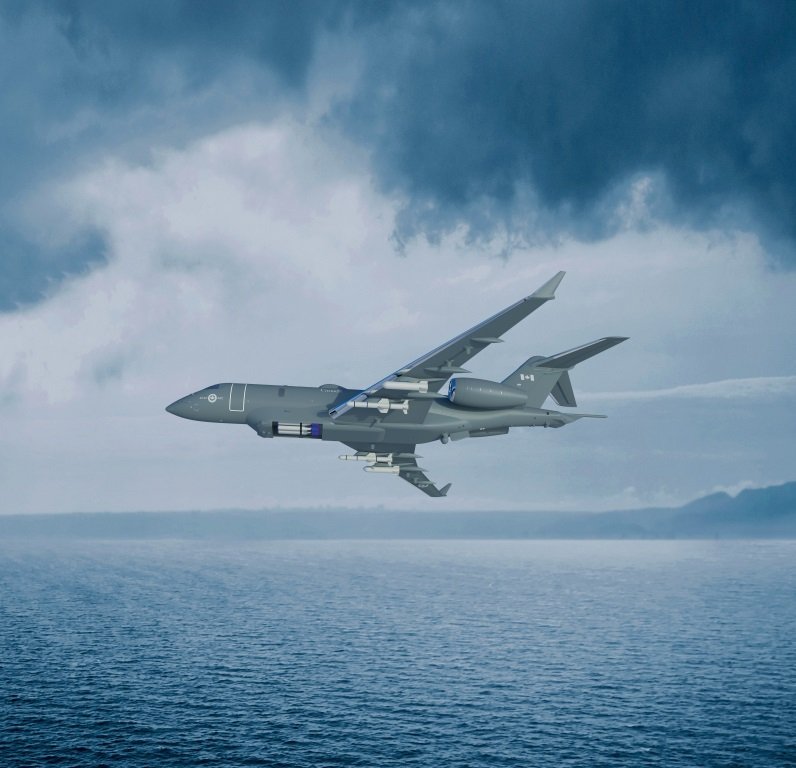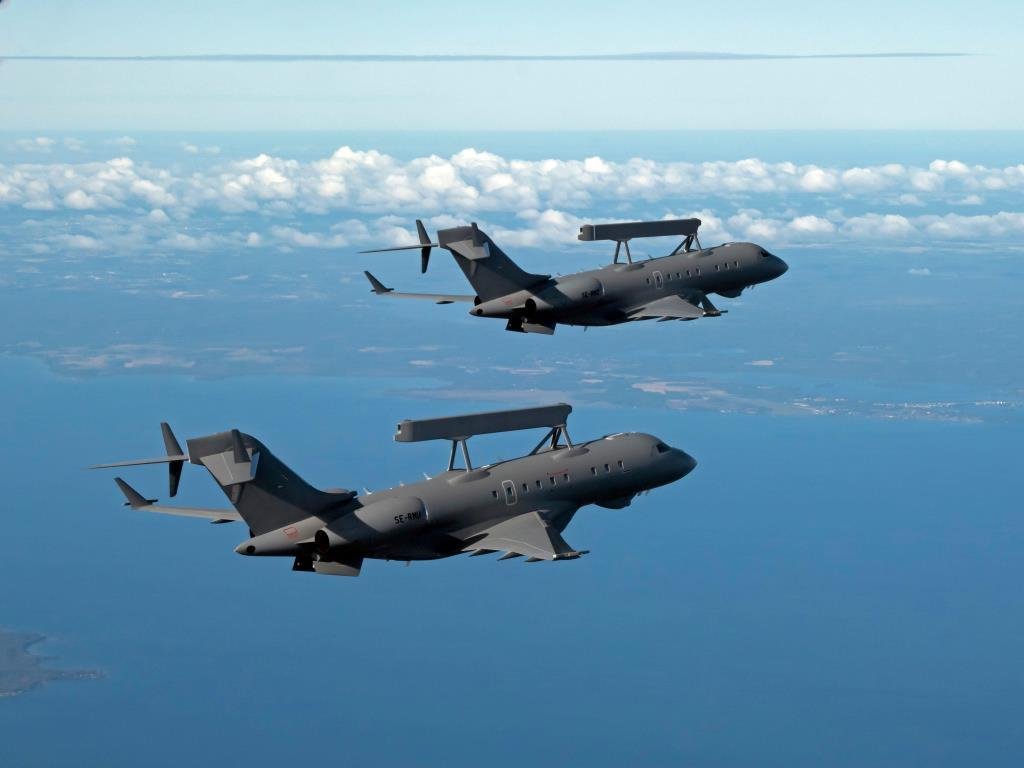COVER STORY - Bombardier Defense Offering a home-grown solution for CMMA
BY JAMES CARELESS
BOMBARDIER Defense
Why the GLOBAL 6500 is a worthy contender for Canada’s Multi-Mission Aircraft program
When people hear the name Bombardier, they think of cutting-edge Challenger and Global business jets. But what most people don’t know is that over 550 of these business aircraft have already been configured for a range of defence missions worldwide. To date, these defence aircraft have flown over 3 million fleet hours, serving with more than 160 operators in over 50 countries.
Bombardier Defense is the division that manages this part of the business. Although it has extensive design, manufacturing, and flight test operations in Montreal, Quebec and Wichita, Kansas, Bombardier Defense is only well-known by its military customers. This is a shame because Bombardier Defense is a company worth knowing about.
“Our mission is to adapt Bombardier’s Challenger and Global business jets to fulfil a wide range of non-traditional applications, such as defence uses, maritime surveillance, medevac, meteorological research, search and rescue, and test beds,” said Steve Patrick, Vice President of Bombardier Defense. “We used to call this division ‘Bombardier Specialized Aircraft’, to capture this idea of anything from a medevac through to a surveillance aircraft. But what has become very clear to us is that a large part of our market is the defence industry. So, Bombardier Defense is here to speak more directly to military services, governments, and the prime contractors, to say ‘we have platforms that can be adapted to your needs’.”
FLYING A RANGE OF MISSIONS
The adoption of Bombardier’s business jets for non-business missions has been driven by customers seeking efficient, cost-effective solutions to their air transport needs. Of these, “the vast majority are being used for medevac,” said Patrick. “Medevac operators very quickly identified that a small jet is ideal for moving critical care patients’ organ transplant over a significant distance.”
In the strictly defence arena, Bombardier Defense has a proven track record with multiple projects to its credit. They include the U.S. Air Force BACN (Battlefield Airborne Communications Node), SAAB’s GlobalEye (an Airborne Early Warning & Control /AEW&C) aircraft), and Germany’s Pegasus Program that uses Bombardier’s Global 6000 for airborne surveillance.
Built upon the Global 6000 platform under the aircraft identifier E-11A, the U.S. Air Force BACN platform provides ‘Wi-Fi in the sky’ service to ground-based warfighters and aerial assets in the battlefield zone. To date, four Global 6000s have been modified and deployed in the E-11A configuration, with a fifth having been ordered in 2021 (along with an option to purchase another five aircraft) under a Indefinite Delivery Indefinite Quantity (IDIQ) contract between Bombardier Defense and the U.S. Air Force.
The BACN term ‘Wi-Fi in the sky’ refers to the E-11A’s ability to extend military communication ranges through this airborne platform, bridging between radio frequencies and interconnecting incompatible communications systems. “I am pleased to see that the Air Force is following through on its purchase of another E-11A aircraft to support battlefield communications for forward-deployed forces,” said Senator Jerry Moran (R-Kansas). “These planes are engineered and outfitted for the Air Force right here in Wichita.”
SAAB’S GLOBALEYE 
The Global 6000/6500 family is the aerial platform for SAAB’s GlobalEye multi-domain Airborne Early Warning & Control (AEW&C) system. Five of these have been acquired by Saab to date, for a range of surveillance missions for this company’s defence customers.
According to Saab’s website, “GlobalEye combines our expertise in complex systems integration, radar, command, control and communication systems into one powerful solution. The Global 6000/6500 aircraft from Bombardier adds over 11 hours of operational endurance, state-of-the-art avionics, and ideal working conditions for all crew members, making it perfectly suited for AEW&C missions.”
“Saab partners with industry leaders, which is why we chose Bombardier’s Global 6000 aircraft as the platform for our advanced Airborne Early Warning and Control solution,” said
Carl-Johan Bergholm, Senior Vice President and Head of Saab Business Area Surveillance. “We are looking forward to continuing our collaboration with Bombardier and Canadian industry.”
The Global 6000 has also been chosen to support Lufthansa Technik’s participation in the HENSOLDT-led PEGASUS program, on behalf of the German armed forces. Bombardier Defense's Wichita facility is making major structural modifications to a Global 6000 to accommodate the "Kalætron Integral" signal intelligence (SIGINT) system developed by HENSOLDT, which collects/analyzes military signals from radar and radio systems. The final integration of this system will be performed at Lufthansa Technik’s special mission aircraft competence centre in Hamburg, Germany. This is the fourth Global 6000 delivered three Global 6000 jets to Lufthansa Technik, since this aircraft was selected for PEGASUS in 2020.
“With the immense progress made in the design work over the last 12 months, we are proud to see the PEGASUS project entering the next stage,” said Jürgen Halder, HENSOLDT’s Vice President of Air SIGINT. “Together with our partners Bombardier Defense and Lufthansa Technik, we are determined to maintain the swift pace established to answer the pressing need of our customer for strategic surveillance capabilities.”
The quality of these clients underlines just how suitable Bombardier Defense’s aircraft are for military applications. “From their perspective, choosing proven business jets like the Global 6000 is a low-risk, low-cost, and highly reliable solution to delivering these sophisticated defence products to their military end users,” Patrick told CDR. “Not having to pursue an expensive, time-consuming ‘clean sheet’ approach meets everybody’s needs, which is why hundreds of Bombardier business jets are fulfilling on-business missions.”
WHY THE GLOBAL 6500 MAKES SENSE
There are many reasons why selecting business aircraft to support military missions makes so much sense. Here are some of them.
In the past, large commercial/military transports — with their higher fuel consumption and maintenance costs — were needed to carry tons of heavy electronic equipment, whether based on vacuum tubes or (somewhat) lighter transistors. But times have changed. “There's more computing power and communications capability in your iPhone today than you could have taken in a large truck 30 years ago,” said Patrick. “When it comes to military technology for airborne communications and surveillance, what used to fill a 747 now fits comfortably into a business jet. Such a smaller platform costs less to acquire, fly, and maintain. It also needs a smaller support team, uses smaller hangars, and can fly out of smaller airports — all of which provides military clients with the multi-mission capabilities they need with enhanced flexibility and at a price tag they can better afford. This is literally a case of getting more for less.”
Not only are business jets more affordable and flexible for defence applications, but they are also easy to customize for all kinds of missions. To this end, Bombardier Defense offers a full range of services to tailor business aircraft to their military clients’ specific needs, in addition to offering complete ‘turnkey’ packages. “Whether you need specialist engineering support and technical oversight for customized services to meet unique mission requirements, or turnkey packages comprising the complete design, building, testing and certification activity of a military mission aircraft, we can do it for you,” Patrick said.
In today’s modern world, commercial jets are being tasked to serve as military platforms. In cargo/passenger situations where heavy lift capability is an absolute must, this makes sense. But in technology-centric applications such as communications, search and rescue, and surveillance, it just doesn’t. Smaller business jets can do everything commercial jets can, but at a lower purchase, operational, and maintenance cost.
Let’s not forget environmental impact: By burning less fuel than commercial jets, business jets are better for the planet. For governments who are serious about climate change, selecting business jets wherever possible for military missions is a smart environmental and public relations choice.
“Our business jets were designed to operate extremely long range,” said Patrick. “They have highly efficient engines and aerodynamics, so the fuel consumption per nautical mile per hour of endurance is significantly less on a business jet than you would have on an airliner. As well, airliners have a different economic case. Most airliners were designed for two-three hour hops. Challenger and Global business jets are designed for long range missions.”
Add Bombardier Defense’s adherence to the highest government certification standards, the proven reliability of its aircraft, and the fact that they can be easily serviced all over the globe, and one can see why so many militaries are using them for defence missions today.
“For many of our military clients, we are ‘the Goldilocks solution’,” Patrick told CDR. “Not too big. Not too small. Just right.”
A WORTHY OPTION FOR CMMA 
On March 27, 2023, the federal government released its ‘Statement on the Canadian Multi-Mission Aircraft (CMMA) for the Royal Canadian Air Force’. “As part of its defence policy Strong, Secure, Engaged, the Government of Canada is seeking to replace the CP-140 Aurora fleet with a Canadian Multi-Mission Aircraft (CMMA) for the Royal Canadian Air Force (RCAF). The CP-140 Aurora fleet was originally procured in 1980, and the aircraft is currently scheduled to retire from service in 2030,” the statement from Public Services and Procurement Canada (PSPC) said.
“A Request for Information (RFI) was released in February 2022 to obtain information from industry,” the PSPC statement continued. “Following engagements with industry and Canada’s closest allies, the government has determined that the P-8A Poseidon is the only currently available aircraft that meets all of the CMMA operational requirements, namely anti-submarine warfare and C4ISR. With a view to exploring this option in more detail, Canada has recently submitted a Letter of Request (LOR) through the United States government’s Foreign Military Sales (FMS) program outlining Canada’s requirements and requesting an offer. These requirements include up to 16 P-8A Poseidon aircraft and associated equipment and initial servicing, as well as access to intellectual property and technical data.”
“The issuance of a LOR does not commit Canada to purchasing the P-8A Poseidon and the project remains in Options Analysis,” the PSPC statement concluded. “The final decision will be based on the capability offered, availability, pricing and benefits to Canadian industry.”
AN OPEN COMPETITION IS REQUIRED
Given that the value of the CMMA contract is estimated to be worth more than $5 billion, the fact that Ottawa is considering sole-sourcing the P-8A without an open competition has raised many eyebrows across Canada, including those of Jacques Roy. He is a professor at the Department of Logistics and Operations Management at HEC Montreal business school.
In a January 16, 2023 Toronto Star opinion article entitled, ‘Contract with Boeing is not the answer to replacing patrol and surveillance aircraft’ (written when the sole-source contract with Boeing was only a rumour), Roy observed that, “It is worrisome that a sole-source contract with a foreign supplier is even being considered as an option ... a full tender should be issued, as planned, allowing Canadian firms, as well as foreign firms, to bid.”
Jacques Roy’s position is shared by Bombardier Defense. “We believe that the Global 6500 aircraft is the right-sized solution for the CMMA due to its next-generation engines, longer range offering, endurance and proven reliability,” said Steve Patrick. “A Canadian innovative and flexible solution, that understands the reality of Canada, is the right choice. All we want is the chance to make our bid in an open competition, as was done for the Future Fighter and the Canadian Surface Combatant procurements.”
The fact that PSPC is considering a single source solution for the CMMA contract is a point of confusion for Bombardier Defense’s VP. “When we look at the requirements for the CMMA as they're expressed in the RFI that came out last February, the Global 6500 can satisfy all of them,” Patrick told CDR. “We believe that it represents the next generation of maritime patrol capability. It's a modern aircraft, highly fuel efficient, fully capable of meeting the mission in production for many years to come, and it offers an exportable affordable solution for a maritime patrol aircraft. This is why we believe that we should have the opportunity to develop a bid for the CMMA procurement and submit that to the Canadian government as part of the decision-making process.”
The RFI that guided PSPC’s decision — “Canadian Multi-Mission Aircraft (CMMA) Project Request for Information (RFI) February 2022 — is a 19-page document posted on buyandsell.gc.ca. Granted, this document was apparently only part of PSPC’s decision-making process regarding the CMMA contract. Still, considering that three of those 19 pages were dedicated to the title, a Table of Contents, and an ‘Acronyms and Definitions’ page (one page a piece), one has to wonder if this was sufficient due diligence for a contract worth more than $5 billion?
After all, the Canadian arm of Bombardier employs more than 10,600 people in various sectors. As such, it has a significant impact on Canadian economic growth. In 2021 alone, Bombardier as a whole contributed nearly $5.7 billion to Canada’s GDP.
Moreover, “Bombardier is the go-to provider of solutions for the most demanding missions, banking on the best Canadian talent for innovation that can be trusted,” said Patrick. “A Canadian company that can be leveraged to work with domestic industry to meet Canada’s defence needs while enhancing domestic innovation and exports should be leveraged. This is being done everywhere else; why not in Canada?”
There is another practical reason to consider replacing the CP-140 with a Global 6500, and that is infrastructure. “If you look at the size of a CP-140 and a Global, they're pretty much the same,” Patrick told CDR. “Where a CP-140 fits well, a Global will fit. So, you don't have to go and invest in larger hangars, longer runways, and reinforce ramps as have other governments who've bought airliner solutions. Saving this money can be significant in the final calculus of defence procurement. That's something that we need to have the Canadian government take into account for the CMMA project, along with overall acquisition, operations and maintenance costs.”
CANADA’S MULTI-MISSION AIRCRAFT TEAM
Given all of these points, it seems only fair and fiscally responsible to allow Bombardier to compete for the CMMA procurement, especially since Canada’s current fleet of CP-140s are undergoing major upgrades that won’t reach full operational capability (Block IV) until Spring 2024. These upgrades “will extend the operational life of the CP-140 Aurora fleet to the 2030 timeframe,” said the ‘CP-140 Aurora fleet modernization and life extension’ web page at Canada.ca. As Jacques Roy asked in his Toronto Star opinion piece, “Why the urgency to act so quickly?”
It was announced on May 18th that Bombardier Defense and General Dynamics Mission Systems-Canada partnered to form ‘Canada’s Multi-Mission Aircraft Team’ to bid on what they hope will be a competitive, open, and transparent procurement process. According to the May 18th press-release “The aircraft will host General Dynamics’ best-in-class integrated mission systems, drawing directly from Canada’s investment in the newly modernized CP-140 Block IV and CH-148 Cyclone. This operationally proven Canadian design forms the basis for the iterative and low risk integration of modernized sensors and systems enabling Canada to leap even further ahead of peers and adversaries alike. This future-proof foundation will also ensure continued operational relevance, responding to Canada’s emergent needs through the middle of this century.”
With Canada’s largest business jet manufacturer and one of Canada’s largest defence contractors joining forces to deliver a Canadian Multi-Mission aircraft, there will no doubt be considerable benefits to the overall Canadian aerospace industry.
All Bombardier Defense wants is a fair chance to bid on the CMMA project. “We're not asking for a sole-source contract to be awarded to Bombardier,” Patrick told CDR. “We're asking for a competitive opportunity to provide a solution to the Canadian Armed Forces. If Bombardier and the Canadian defence industry advocates for this, our hope is that the Canadian government would realize a competitive tender will always result in a better solution than a non-competitive sole-source. We hope Canada does the right thing.”
James Careless is CDR’s Ottawa Bureau Chie

